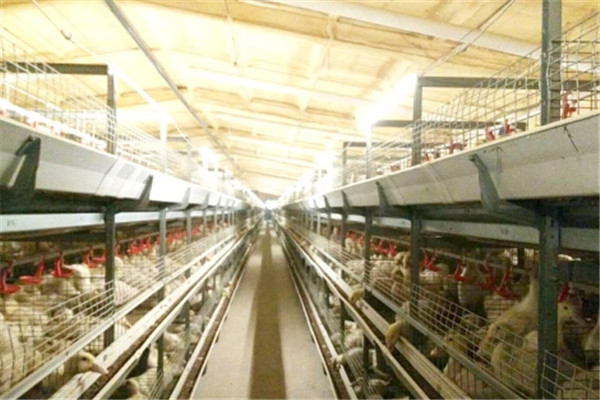How to prevent stacking layer chicken equipment fatigue? Egg cage breeding, fatigue is preventable, in the breeding process to take effective preventive measures can avoid the induction of fatigue, following the Mingfei animal husbandry Xiaobian together to find out about it.
The hens are provided with coarse-grained (greater than 0.75mm) limestone powder or shell powder. The coarse-grained calcium feed has a slower speed through the muscle stomach, and a larger part is absorbed by the intestine during the formation of the eggshell at night, which contributes to the formation of eggshells. Provide dietary calcium. Calcium-grade "precipitation" during feed production, transportation or feeding should also be avoided, and the adverse effect of calcium carbonate fine powder on feed palatability should be avoided. The coarse-grain calcium source can account for 1/3-2/3 of the total calcium, and the calcium source particles should not be less than 75m. For laying hens that are at the peak of egg production or in hot climate conditions, roughly 1 % of the daily feed consumption will be used to evenly spread coarse-grain calcium in the chute. This will not only provide food calcium for eggshell formation. , but also stimulate the flock to eat feed. Ensure comprehensive nutrition and scientific management, so that when the broiler matures, it achieves the best weight and body condition. During 15 to 16 weeks, special pre-opened feeds containing 2% to 3% calcium are fed, and when the egg production rate reaches 50%, the feed for laying hens will be changed in time. Practice has shown that osteoporosis rarely occurs in laying hens raised on this calcium nutrition program. The calcium level in the high-yielding layer should be 3.75%, and the appropriate ratio of calcium and phosphorus should be ensured, and more than 32 000 IU of VD should be added per kg of diet. For example, if the flock intake is small or in hot season, the calcium content can be increased to 3.8% to 4%, and the amount of vitamin D3 added, so that the daily calcium intake of each hen reaches 3.5 g or more. The above is the introduction of avoiding the attack of laying hen cage fatigue. Through effective preventive measures, ensuring the interests of customers is the most effective means of protection.
What are the advantages of egg cage breeding? Now most of laying hens choose chicken cage breeding. What are the benefits of cage breeding? Let's take a look at the following: The advantages of breeding specialized household cages: 1. Small footprint and high stocking density. Since aviation hens are used as examples, free-range chickens can only feed 2 to 5 eggs per square meter, while caged laying hens and chickens are kept in cages. They can make full use of the shed space and raise the stocking density. Generally, they can raise the breeding density per square meter. 20 or so. 2. Labor productivity is high when labor is saved. Cage-laying hens have realized centralized management. Feeding, feeding water, collecting eggs, excreting, etc. are all convenient. They can reduce labor intensity, save labor and working hours, and increase labor productivity. For loose-breeding chickens, one person can only keep about 50 to 100 eggs, while raising chickens in cages can raise more than 400 eggs. 3. To facilitate the prevention and control of the spread of the disease. There are many opportunities for free-range chickens to come into contact with the epidemic source. Individual chickens are not easy to find in the early stages of the disease, spreading chickens and other diseases quickly. Caged chickens do not come into contact with faeces and ground, which can prevent or reduce the occurrence of infectious diseases and parasitic diseases. Chicken cages and chicken houses can be sterilized on a regular basis and the chicken positions are fixed. Individuals who get sick early can easily find out from chicken droppings and feed intake.
Compared with free-range chickens in farmer's cages, it has the following advantages: 1. It saves space and has a high stocking density; In addition to the sheds that require a certain area, it requires a certain range of sports grounds. Generally, only 3 can be kept per square meter. ~ 5 animals; cage chicken farmhouse space can be fully utilized, usually 10 to 20 per square meter.
Cascade type laying chicken equipment spray disinfection advantages: 1.1 disinfection, the effect is significant. Spray disinfection of cage chickens can completely and comprehensively kill pathogenic microorganisms in chicken houses, cages and chickens. For example, there is a good preventive effect against Malick's disease, infectious bursal disease and Newcastle disease. It has a good preventive effect against bacterial diseases caused by E. coli, Staphylococcus, and Salmonella. Especially for respiratory diseases, such as infectious rhinitis, septicemia, etc. better control effect.
























